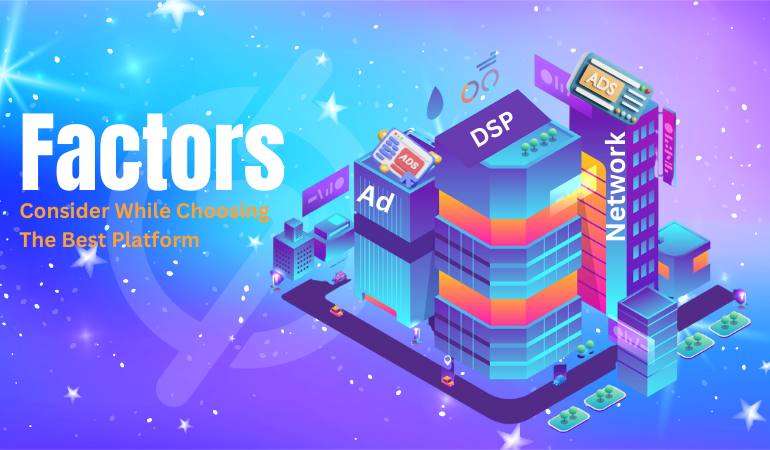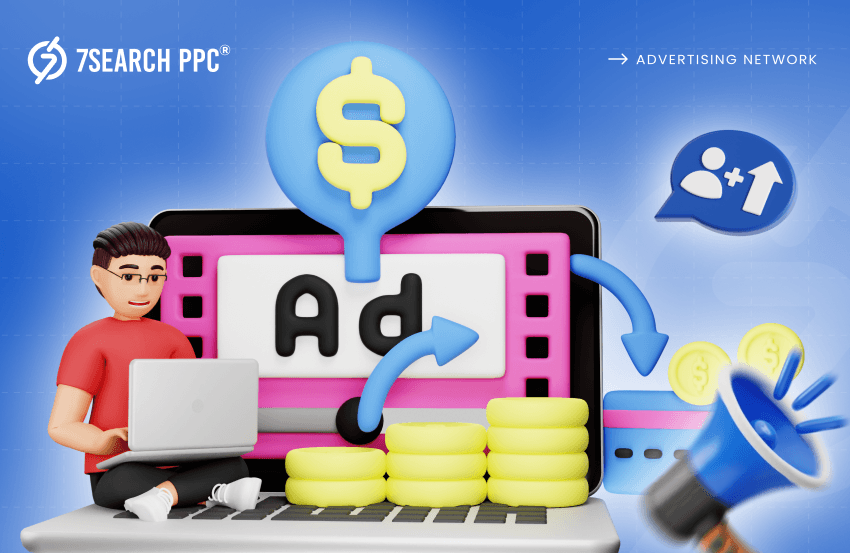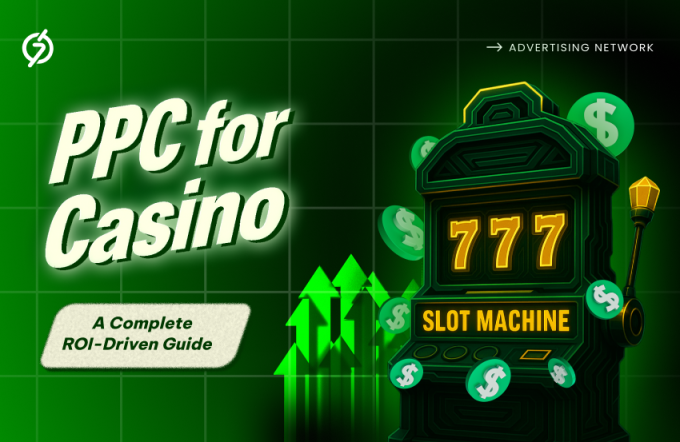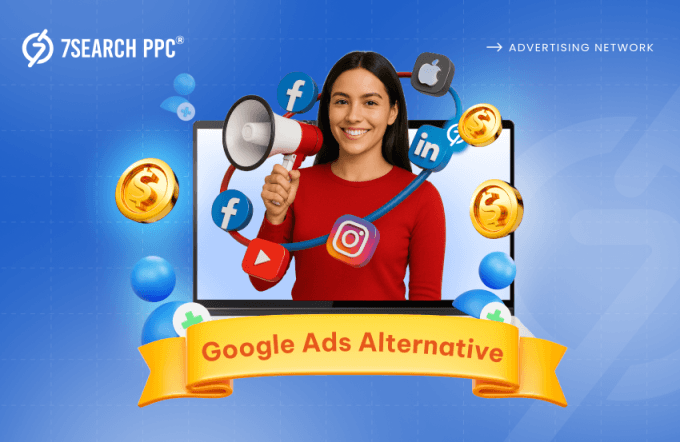As an advertiser who has only recently begun advertising, you hear the words Ad Network and DSP being thrown around everywhere. Sometimes, it even gets down to Ad Network vs. DSP. Even after you’ve led successful advertising campaigns, the debate seems to have no end. Experienced advertisers might even have strong opinions on what they prefer.
But if the end goal is to buy advertising space, what’s all this fuss about? You can advertise and carry out successful campaigns through both. But, the actual difference lies in the features they provide, which may or may not align with your requirements.
Both ad networks and DSPs attract a good number of advertisers. Let’s understand all the reasons behind it with this blog.
Ad Network vs. DSP: The Web They Create
Before we debate about ad network vs. DSP, let’s first give you a rough vision of the web that both create.
When it comes to advertising networks, this is how they work. Imagine the ad network in the center as a big block, acting as a mediator for the media buying process. From one side, it branches out to advertisers, and from the other, it branches out to publishers.
It’s a bit different for DSPs (Demand Side Platforms). Imagine them in the center again. On one side are the advertisers. And on the other side, it has branched out to multiple publishers, SSPs (supply-side platforms), ad networks, and ad exchanges.
Now, it might look like DSPs here have better reach and scope, but that’s not all true. Let’s learn more about them both.
Defining Ad Networks
Ad networks are platforms that connect advertisers with multiple website publishers and automate the entire buying and selling process. First, they collect ad inventory from publishers who wish to monetize their content.
Later, they sell this inventory to advertisers who have registered with the network. This way, they act as an intermediary between advertisers and publishers, helping one advertise and the other monetize.
On the demand side, they offer advertisers the ability to sign up with their advertiser account, which gives them complete control over their campaigns. Advertisers can then create and adjust their campaigns with the sophisticated set of tools they provide.
On the supply side too, most advertising networks provide publishers an account where they can keep track of their income and update ad inventory.
Defining DSPs
DSPs, or Demand-Side Platforms, are software restricted to advertisers only. Advertisers first sign up with the DSP and create their ad campaigns.
The DSP then scours through its list of networks, which could either be individual publishers, advertising networks, or ad exchanges. The conversions on your ad campaigns totally depend on the quality of the DSP’s networks.
Similar to ad networks, DSPs also work on a programmatic advertising system that automates the buying process for advertisers.
Ad Network vs. DSP: The Differences
The question still remains unanswered. Ad Network vs. DSP, which one is better? Let’s look at the few factors that you should consider before making your decision.
The Platform Fees
Platform fees are a deal-breaker for many advertisers. Imagine fixing your budget and setting up the whole campaign, only to later find out that you’ll also be charged extra platform fees. There goes all your budget planning.
Sadly, this is the case for DSPs. DSPs charge you not one but multiple fees. You will have to spend on managed service fees, third-party rev share, percentage of ad spending, add-on fees for specific tools, and handling RTB costs. These usually range between 8% and 30% and often leave the advertisers feeling dissatisfied with their campaigns.
This problem doesn’t arise when you’re using an advertising platform. Most advertising networks never charge you any platform fees or require you to make payments while registering. You only spend bidding on ad spaces.
Ad Server
Ad servers are technological systems in the digital advertising network responsible for the delivery and management of ads.
Most ad networks have an in-built ad server that securely holds the information and data of the publishers and advertisers registered with it. This ensures timely delivery and quick optimization of ad campaigns.
DSPs, on the other hand, can either have their own in-built server or use third-party ones. Always be careful when you’re using DSPs with third-party servers, as they are prone to data breaches and privacy lapses.
Centralized Platform
Ad networks are centralized platforms that create a common space for advertisers and publishers. They are responsible for overseeing the network of publishers, collecting and organizing the ad space, curating appropriate inventory for advertisers, and negotiating ad rates. Right from creating their campaigns to measuring analytics and optimizing them, advertisers can do everything under a single roof.
DSPs are not centralized platforms and only provide a functioning space to the advertisers. This may or may not limit the features, tools, and functions that you have access to. Moreover, since they are not responsible for overseeing the publishers, the traffic quality you get might not be the best.
Networks and Reach
Ad networks are only connected with publishers. They collect (or buy) inventories from many publishers in a variety of niches. After analyzing the ad inventory, they help negotiate the bids further.
DSPs, on the other hand, have plenty of connections and networks. This includes ad networks, individual publishers, SSPs (supply-side platforms), and ad exchanges. This ensures that you have better chances of advertising on premium websites.
Quality of Ad Inventory
When it comes to ad network vs. DSP, the quality of inventory is a significant factor. It is determined by the relevancy and genuineness of the traffic it can generate. This excludes all bot and irrelevant traffic. After all, why would you pay for traffic that’s not even relevant to you?
Advertising networks win this category as they focus more on providing better-quality inventory rather than quantity. Most of them set a benchmark for publishers that considers the average amount of traffic they must have to monetize with the platforms, ensuring superior traffic.
However, since DSPs focus more on providing increased quantity, they might overlook the quality of traffic.
Ad Networks and DSPs: The Similarities
For plenty of advertisers, Ad Network vs. DSP isn’t even a topic of debate. We’ll tell you why.
Ad networks and DSPs share similarities in automating the media buying process, targeting criteria, transparency in performance metrics, bidding models, and other customization features. Both work to serve advertisers just as actively, always adhering to the latest trends and integrating updates.
So, how can you make a decision between them? Instead of looking at the differences, we recommend examining factors that will help determine the best-suited platform for you. Let’s take a look at them.
Factors to Consider While Choosing The Best Platform
You need to reflect on a few factors before settling down with an ad network or a DSP. Consider thinking about the following.

How can you target?
How do you segment your audience, and how can you reach them? Some ad campaigns require you to target ads based on age, while others perform best when targeted locally.
So, look for platforms that provide advanced targeting options. This generally includes targeting on the basis of demographics, location, and online behavior of your audience. Plus points if the platform also offers contextual targeting and retargeting.
Is it affordable?
Ad network vs. DSP—what can your business afford? Both are good options, but you need to decide what fits your budget better. Generally speaking, small and mid-sized businesses usually prefer advertising networks because of their affordability.
However, the best thing to do is evaluate the cost structure of both first. For DSPs, combine all the platform fees and bidding prices. For advertising networks, look at the bidding models and average bidding rates. Whichever falls under your budget gets a point.
What’s transparency like?
How much transparency do you expect from the platform?
Analyze the platform for the following:
- Clear insights into the performance of campaigns
- Accurate data and detailed statistics
- Access to real-time data
Your future and current campaigns depend on this data, so never settle for a platform that offers anything less.
Do you have control over campaigns?
Having control over your campaigns is super important to assure that everything goes smoothly as planned. Look for ad networks and DSPs that offer:
- real-time changes
- automation of repetitive tasks
- optimization of keywords and bids
- setting budget limits
- additional customization options
Such features help you adapt to market changes and enhance your strategies quickly.
Ad Network vs. DSP: Making the Final Decision
Now that we are nearing the end of the blog, it’s time to make a decision. Ad network vs. DSP- what’s it going to be?
One major factor to consider is the differences. If any of the differences we just mentioned give you a significant reason to choose one over the other, go for that. For instance, if having a centralized platform is important for you, then an advertising network is what you choose. If it’s not a major concern, then you can choose either.
Next, we come to the similarities. Ad networks and DSPs share plenty of similarities, making both equally competent. But this isn’t always the case. Features provided by each platform vary from one platform to another. One DSP could give you the most advanced features, but another might not even provide the basic ones.
Lastly, you analyze which one fits your requirements based on a few factors. Here, you consider things like targeting capabilities, affordability, transparency, and control. This is your final deciding point.
Conclusion
That was everything you needed to know about the ad network vs. DSP debate. Well, it’s not really as big of a debate as people make it out to be. Except for a few key differences, it’s mostly about what each platform can offer individually. All you need to do is understand your requirements first and then align them with what the ad network or DSP has to offer.
So… Ad Network vs. DSP, do we have an answer yet?
Frequently Asked Questions (FAQs)
What is the difference between ad networks and DSPs?
Ans. Ad networks and DSPs differ in terms of platform fees, ad servers, centralization, users, networks, and the quality of ad inventory.
What are the similarities between ad networks and DSPs?
Ans. Ad networks and DSPs share similarities in terms of automating media buying, targeting capabilities, bidding models, performance monitoring features, and campaign customizations.
Ad network vs. DSP- how can I choose between both?
Ans. You can choose between both by analyzing your needs and aligning them with the features offered by the platforms.
Who are the users of the ad network?
Ans. Advertisers, publishers, advertising agencies, SSPs, and DSPs are the main users of the advertising network.
Ad network vs. DSP- which is more suitable for small and mid-sized businesses?
Ans. Ad networks are more suited for small and mid-sized businesses as they offer optimal bidding rates with no extra fees or charges.
















